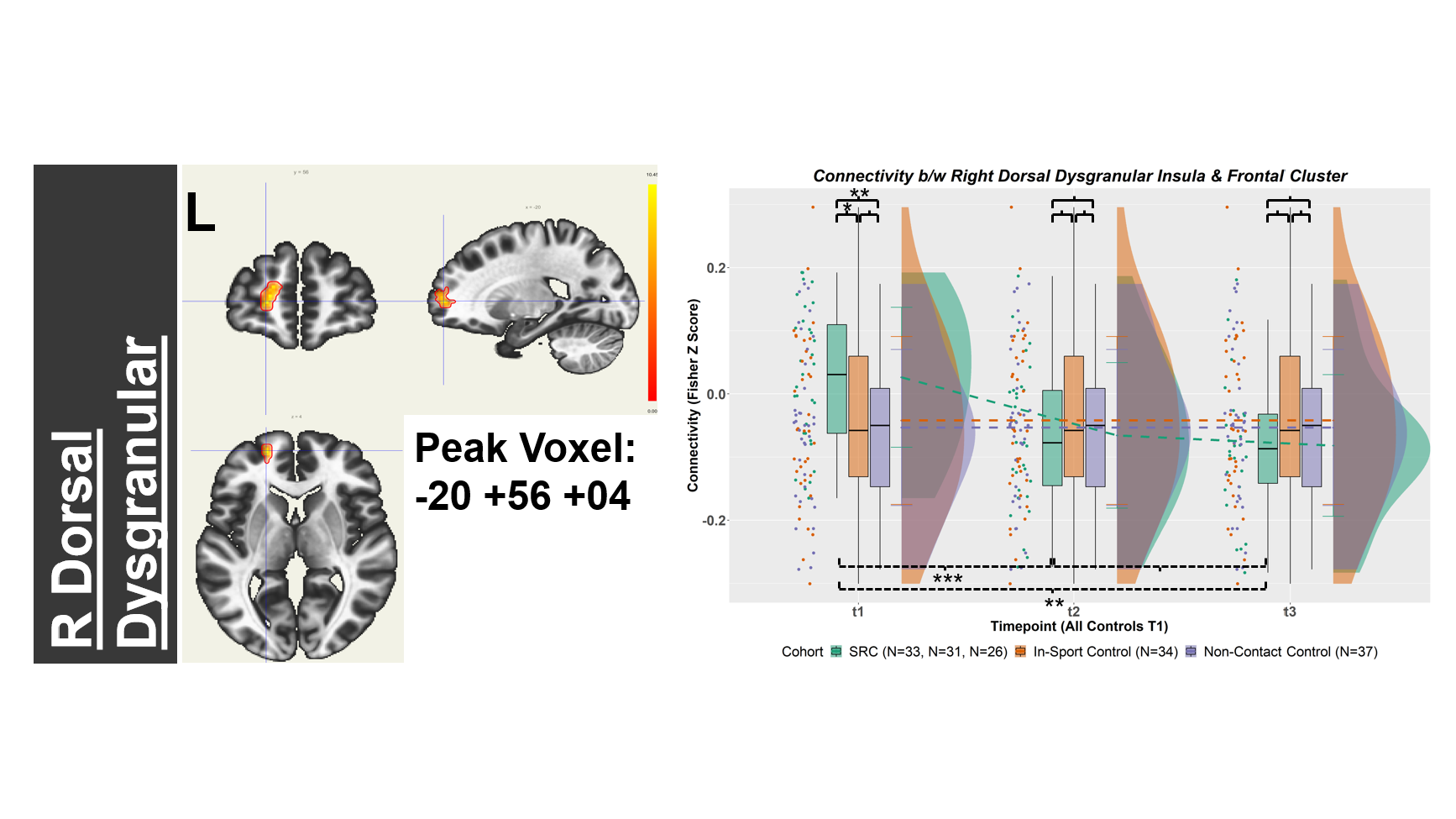Your message has been sent.
 CLOSE SIDEBAR
CLOSE SIDEBAR

Resting-State Connectivity Between the Insula and the Prefrontal Cortex Is Sensitive to Injury and Recovery after Sport-Related Concussion
Christopher A Sheridan
Poster Title: Resting-State Connectivity Between the Insula and the Prefrontal Cortex Is Sensitive to Injury and Recovery after Sport-Related Concussion
Student: Christopher A. Sheridan, CSCS
Faculty Mentor and Department: Christopher T. Whitlow, MD, PhD, MHA, Department of Radiology; Meeryo C. Choe, MD, UCLA DGSoM Department of Pediatrics, Division of Neurology
Funding Source: The Harry O. Parker Neuroscience Research Fund
ABSTRACT
Background: Autonomic, affective, and nociceptive symptoms are common after sport-related concussion (SRC). These symptom domains have well-established relationships with structures of the central autonomic network (CAN) – neural circuitry involving limbic regions of the prefrontal, insular, cingulate, and temporal cortices and their subcortical targets in the striatum, thalamus, hypothalamus, and brainstem. We have found previously that concussed athletes showed acutely increased connectivity between networks associated with the medial and ventrolateral amygdala. Heart-rate variability was associated with connectivity trajectory over time, and persistently elevated connectivity 3 months post injury was correlated with symptom persistence. Symptom persistence was strongly positively correlated with chronic hyperconnectivity between the medial amygdala and voxels in the ventromedial prefrontal cortex/ subgenual anterior cingulate cortex (vmPFC/sgACC). We hypothesized that other critical hubs of the CAN, especially the insula, might also display hyperconnectivity with the vmPFC/sgACC, supporting our working theory that the vmPFC is a promising target for therapeutic neuromodulation.
Hypothesis:Seed-to-voxel analysis of the left and right insula will reveal a general pattern acute hyperconnectivity to structures in the vmPFC and sgACC followed by a decline to control-level connectivity over time.
Methods: We computed whole-brain seed-to-voxel connectivity maps from BOLD rsfMRI acquisitions at three time points after a sport-related concussion (T1=1-4 days, T2=10-14 days, T3=2-3 months) in collegiate athletes (N=31; female=14) and for two groups of healthy age- and gender-matched controls participating in the same sport (N=36, female=17) and in a non-contact sport (N=37; female=15). Insula seeds for cluster analysis were selected from the Brainnetome 264 Atlas. Voxel threshold was set at an uncorrected p<0.001 (two-sided), and cluster threshold was set at a cluster-size false discover rate (FDR) corrected p-FDR<0.001 (F[4,206]>4.81; k≥153). Two-way repeated measures ANOVA was used to assess significant differences across group and time for each cluster identified.
Results: Eight of 12 insular seed regions contained at least one cluster of voxels in the vmPFC/sgACC which differed significantly in connectivity across group and time. Nine clusters from the following seeds were identified: L hypergranular F(2,31)=8.39, p-FDR<0.001; L ventral agranular F(2,31)=11.55, p-FDR<0.001; R ventral agranular F(2,31)=7.58, p-FDR<0.001; L dorsal agranular F(2,31)=10.44, p-FDR<0.001; L ventral granular F(2,31)=25.45, p-FDR<0.001; R ventral granular F(2,31)=11.08, p-FDR<0.001; L dorsal granular F(2,31)=13.95, p-FDR<0.001 and F(2,31)=8.37, p-FDR<0.001; L dorsal dysgranular F(2,31)=7.74, p-FDR<0.001. A parametric decrease in connectivity within the mTBI group over time was observed for all clusters except the smaller cluster associated with the L dorsal granular insula. For all clusters, connectivity was at or below control-level by the chronic time point.
Conclusions: Taken together with our previous work, these findings suggest that acute hyperconnectivity between important hubs of the central autonomic network (i.e., the amygdala and the insula) and the vmPFC may be key component of early response to SRC and that normalizing connectivity to vmPFC regions over time may represent a key marker of physiological recovery.
Source of mentor’s funding or other support that funded this research: NIH SBIR R44NS092209; the UCLA Steve Tisch BrainSPORT Program; UCLA Easton Clinic for Brain Health; UCLA Brain Injury Research Center; and Stanley and Patti Silver.
-
Supporting Documents
- Resting-State Connectivity Between the Insula and the Prefrontal Cortex Is Sensitive to Injury and Recovery after Spo...
Powered by Acadiate
© 2011-2024, Acadiate Inc. or its affiliates · Privacy
